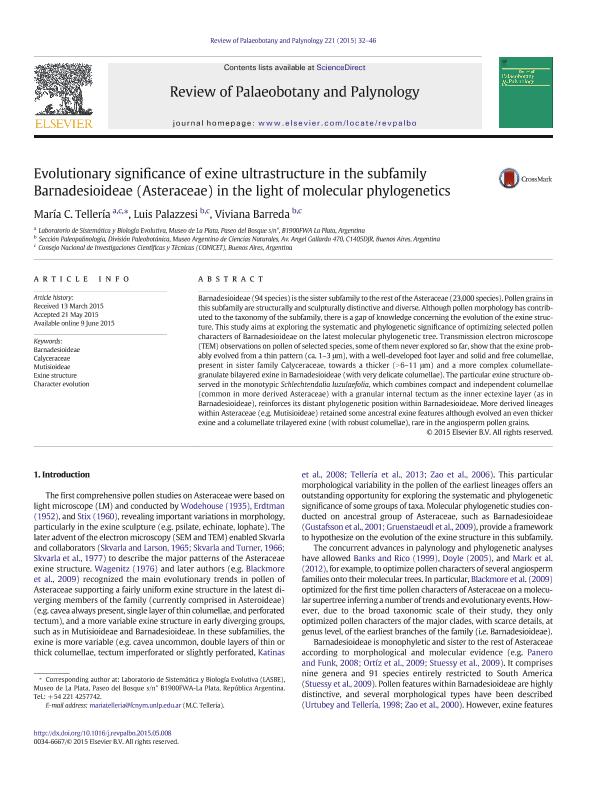Mostrar el registro sencillo del ítem
dc.contributor.author
Tellería, María Cristina

dc.contributor.author
Palazzesi, Luis

dc.contributor.author
Barreda, Viviana Dora

dc.date.available
2018-05-30T16:51:17Z
dc.date.issued
2015-10
dc.identifier.citation
Tellería, María Cristina; Palazzesi, Luis; Barreda, Viviana Dora; Evolutionary significance of exine ultrastructure in the subfamily Barnadesioideae (Asteraceae) in the light of molecular phylogenetics; Elsevier Science; Review of Palaeobotany and Palynology; 221; 10-2015; 32-46
dc.identifier.issn
0034-6667
dc.identifier.uri
http://hdl.handle.net/11336/46632
dc.description.abstract
Barnadesioideae (94 species) is the sister subfamily to the rest of the Asteraceae (23,000 species). Pollen grains in this subfamily are structurally and sculpturally distinctive and diverse. Although pollen morphology has contributed to the taxonomy of the subfamily, there is a gap of knowledge concerning the evolution of the exine structure. This study aims at exploring the systematic and phylogenetic significance of optimizing selected pollen characters of Barnadesioideae on the latest molecular phylogenetic tree. Transmission electron microscope (TEM) observations on pollen of selected species, some of them never explored so far, show that the exine probably evolved from a thin pattern (ca. 1–3 μm), with a well-developed foot layer and solid and free columellae, present in sister family Calyceraceae, towards a thicker (> 6–11 μm) and a more complex columellate-granulate bilayered exine in Barnadesioideae (with very delicate columellae). The particular exine structure observed in the monotypic Schlechtendalia luzulaefolia, which combines compact and independent columellae (common in more derived Asteraceae) with a granular internal tectum as the inner ectexine layer (as in Barnadesioideae), reinforces its distant phylogenetic position within Barnadesioideae. More derived lineages within Asteraceae (e.g. Mutisioideae) retained some ancestral exine features although evolved an even thicker exine and a columellate trilayered exine (with robust columellae), rare in the angiosperm pollen grains.
dc.format
application/pdf
dc.language.iso
eng
dc.publisher
Elsevier Science

dc.rights
info:eu-repo/semantics/openAccess
dc.rights.uri
https://creativecommons.org/licenses/by-nc-sa/2.5/ar/
dc.subject
Barnadesioideae
dc.subject
Calyceraceae
dc.subject
Exine Structure
dc.subject
Character Evolution
dc.subject
Multisioideae
dc.subject.classification
Otras Ciencias Biológicas

dc.subject.classification
Ciencias Biológicas

dc.subject.classification
CIENCIAS NATURALES Y EXACTAS

dc.title
Evolutionary significance of exine ultrastructure in the subfamily Barnadesioideae (Asteraceae) in the light of molecular phylogenetics
dc.type
info:eu-repo/semantics/article
dc.type
info:ar-repo/semantics/artículo
dc.type
info:eu-repo/semantics/publishedVersion
dc.date.updated
2018-05-24T14:26:33Z
dc.journal.volume
221
dc.journal.pagination
32-46
dc.journal.pais
Países Bajos

dc.journal.ciudad
Amsterdam
dc.description.fil
Fil: Tellería, María Cristina. Universidad Nacional de La Plata. Facultad de Ciencias Naturales y Museo. Laboratorio de Sistemática y Biología Evolutiva; Argentina. Consejo Nacional de Investigaciones Científicas y Técnicas; Argentina
dc.description.fil
Fil: Palazzesi, Luis. Consejo Nacional de Investigaciones Científicas y Técnicas. Oficina de Coordinación Administrativa Parque Centenario. Museo Argentino de Ciencias Naturales "Bernardino Rivadavia"; Argentina
dc.description.fil
Fil: Barreda, Viviana Dora. Consejo Nacional de Investigaciones Científicas y Técnicas. Oficina de Coordinación Administrativa Parque Centenario. Museo Argentino de Ciencias Naturales "Bernardino Rivadavia"; Argentina
dc.journal.title
Review of Palaeobotany and Palynology

dc.relation.alternativeid
info:eu-repo/semantics/altIdentifier/doi/https://dx.doi.org/10.1016/j.revpalbo.2015.05.008
dc.relation.alternativeid
info:eu-repo/semantics/altIdentifier/url/https://www.sciencedirect.com/science/article/pii/S0034666715001128
Archivos asociados
